Tauchen mit Ziegenfische
Meeresleben von Lanta | Mullidae
Es gibt etwa 40 Arten von Meerbarben, die alle durch zwei lange Barteln am Kinn gekennzeichnet sind, mit denen sie im Sediment nach Nahrung suchen. Sobald sie ihre Beute gefunden haben, graben sie sich mit ihren Barteln und ihrer Schnauze in das Sediment ein, um nach kleinen Krebstieren und Würmern zu suchen. Ihr niedriger Mund und ihr kurzer Unterkiefer sind für diese Aufgabe perfekt geeignet. Die langen Sinnesbarteln können in eine Vertiefung am Hals eingeklappt werden, und diese Fische sind beim Tauchen vor Koh Lanta häufig zu sehen.
Ziegenfische haben zwei deutlich voneinander getrennte Rückenflossen und eine gegabelte Schwanzflosse. Kopf und Körper sind mit Schuppen bedeckt, und die meisten Arten weisen charakteristische schwarze, braune, rote oder gelbe Markierungen auf. Die meisten Arten sind außerdem in der Lage, ihre Farbe schnell zu ändern.
Sie sind in der Regel auf offenem Sand- oder Schlammboden anzutreffen, zumindest zum Fressen, und begeben sich in Korallengebiete, um dort Reinigungsstationen und kleine Putzerfische aufzusuchen, die abgestorbene Schuppen und Parasiten von ihrem Körper und ihren Kiemen entfernen.
6 Arten auf dieser Seite gefunden:
Freckled Goatfish
(Upeneus tragula)
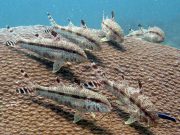
Upeneus tragula @ Koh Haa
The freckled goatfish, also known as the bar-tail goatfish, has a whitish or tan body with a heavy mottling of brown blotches, spots and lines.
This species has a dark yellowish to brown stripe from snout to tail, and all fins have red, brown or black stripes, bars or blotches. The first dorsal fin has a large dark blotch around the tip and there are dark bars on the tail fin lobes. The barbells are yellow.
The freckled goatfish may rapidly change to tan or red with a dark red stripe from the snout to the tail.This phase change may occur during cleaning or when sleeping at night.
This species grows to a maximum of 30 cm, but is usually observed much smaller, in the 15 - 20 cm range in small groups or solitary. The freckled goatfish is found on the reef edge, foraging for food in the sand and rubble areas.
Dash-Dot Goatfish
(Parupeneus barberinus)
The dash-dot goatfish grows to 50 cm and has a usually white body. The upper back may be yellowish or dark reddish, with a darker stripe running from the snout to below the second dorsal fin. The dark stripe has a much lighter silvery-bluish stripe below this. There is a large dark blotch on the tail base.
This species is capable of changing colour very quickly. The dash-dot goatfish may also display thick vertical banding on its sides which highlights the lighter stripe running from the snout to tail base. The lighter silvery-bluish stripe is much more obvious during the dark colouration phase.
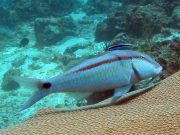
Parupeneus barberinus @ Koh Haa
In some texts this colour change is claimed as a red-variation existing in species from deeper water. The photos here were taken at 15 m and show an obvious rapid colour change from the 'light variation' to the 'red variation'. Rather than two distinct 'variations' depending on depth, it is much more likely that this species exhibits a reddish colour phase during cleaning and sleeping at night, as has already been documented with the freckled goatfish (Upeneus tragula).

Dash-Dot Goatfish rapid colour change
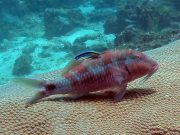
Dash-Dot Goatfish rapid colour change
The dash-dot goatfish is usually solitary but may form small groups. This species is often found over sandy or coral rubble areas close to the reef edge. Photos here show this goatfish species at a cleaning station on the reef edge at Koh Haa, along with rapid colour change.
Cinnabar Goatfish
(Parupeneus heptacanthus)
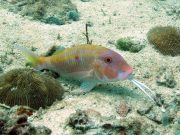
Parupeneus heptacanthus @ Koh Bida
The Cinnabar Goatfish is a brownish yellow to light red fish, capable of very rapid changes in body colour and pattern.
There are iridescent blue stripes and markings around the eyes and along the upper body. There is a small reddish brown spot on the mid-side.
The Cinnabar Goatfish grows to 36 cm and is usually seen solitary or in small groups over sand and coral rubble areas searching for food.
Goldsaddle Goatfish
(Parupeneus cyclostomus)

Parupeneus cyclostomus @ Koh Haa
The Goldsaddle Goatfish has a highly variable colour, including purple, blue, green, yellow and brown.
Often there is a yellow saddle just forward of the tail base, below the second dorsal fin.
All colour variations have several small blue lines and streaks around the eyes.
The Goldsaddle Goatfish is capable of rapid colour change to a bright yellow, or deep gold colour, except for the blue lines and streaks around the eyes.
The Goldsaddle Goatfish grows to 50 cm and feeds during the day.
The diet includes small fishes, crustaceans, worms, shrimps, crabs, octopi, and small gastropods.
Yellowfin Goatfish
(Mulloidichthys vanicolensis)
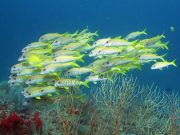
Mulloidichthys vanicolensis @ Koh Haa
The yellowfin goatfish grows to 38 cm and has a whitish to pinkish body with a yellow back, and a yellow stripe running from the eye to the base of the tail fin. The fins are yellow.
During the day the yellowfin goatfish forms large groups which are relatively inactive/stationary. These groups then disperse to feed on sand-dwelling worms and crustaceans, normally at night.
Occasionally individuals are seen feeding on the sandy bottom during the day.
Yellowstripe Goatfish
(Mulloidichthys flavolineatus)

Mulloidichthys flavolineatus @ Koh Haa
The Yellowstripe Goatfish has a silvery white body with a yellow stripe on the side which is bordered by two very faint pale bluish stripes.
There is a black rectangular or oval mid-body spot on the the yellow stripe which can be rapidly darkened or faded.
The fins are partially translucent, and the barbels are white.
The Yellowstripe Goatfish grows to 40 cm and is usually seen in small groups during the day over sandy reef areas.
Feeds on crustaceans, molluscs, worms and small urchins.
Tauchen mit Ziegenfische rund um Koh Lanta
Tauch- und Schnorchelausflüge
Wenn Sie gerne die Gelegenheit hätten, Ziegenfische auf einem unserer täglichen Tauchausflüge während der Hochsaison von Koh Lanta aus zu sehen, dann senden Sie uns eine E-Mail an info@diveandrelax.com.
Nehmen Sie an unseren Speedboot-Tauchausflügen in der Hochsaison zu einigen der besten Tauchplätze Thailands teil und genießen Sie kleine Gruppen, kurze Fahrzeiten und einen Fokus auf hervorragenden persönlichen Service, Sicherheit und Spaß.
Noch kein zertifizierter Taucher? Lernen Sie auf Koh Lanta das Tauchen mit dem 3-tägigen SSI Open Water Diver Kurs.
Buchen Sie online und sparen Sie 10% auf Tauchausflüge und Tauchkurse auf Koh Lanta.
Weitere Informationen
Indo-Pazifische Meereslebewesen-Führer
- Allen, G., Steene, R., Humann, P., DeLoach, N. (2003) Reef Fish Identification, Tropical Pacific. Jacksonville, FL., USA: New World Publications, Inc., ISBN 1-878348-36-1.
- Humann, P., DeLoach, N., (2010) Reef Creature Identification, Tropical Pacific. Jacksonville, FL., USA: New World Publications Inc., ISBN 978-1-878348-44-9
- Debelius, H. (2013) Indian Ocean Reef Guide. Frankfurt, Germany: IKAN - Unterwasserarchiv, ISBN 978-3-939767-52-7.
- Debelius, H. (2004) Nudibranchs and Sea Snails, Indo-Pacific Field Guide. Frankfurt, Germany: IKAN - Unterwasserarchiv, ISBN 3-925919-51-1
- Erhardt, H., Knop, D. (2015) Corals Indo-Pacific Field Guide. Frankfurt, Germany: IKAN - Unterwasserarchiv, ISBN 3-925919-69-4.
- Veron J.E.N., Stafford-Smith M.G., Turak E. and DeVantier L.M. (2016). Corals of the World
Weitere Referenzen zu Meereslebewesen und weitere Informationen
